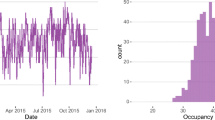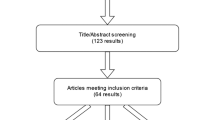Abstract
An analytical queuing network algorithm for the optimal egress problem within buildings is presented with an example of its use and potential application to more general facility types.
Similar content being viewed by others
References
Barbour, A. D., “Networks of Queues and the Method of Stages,”Advances in Applied Probability, Vol. 8, No. 3 (1976), pp. 584–591.
Baskett, F. et al., “Open, Closed, and Mixed Networks of Queues with Different Classes of Customers,”JACM, Vol. 22, No. 2 (1975), pp. 248–260.
Berlin, G. N., “A Modeling Procedure for Analyzing the Effect of Design on Emergency Escape Potential,” working paper from the National Fire Protection Association, Quincy, MA (1979a).
Berlin, G. N., “A System for Describing the Expected Hazards of Building Fires,” paper presented at an International Symposium of Fire Risk in Industry, Stockholm, Sweden (1979b).
Berlin, G. N., “A Statistical Model of Fire Development Variability,” paper presented at the Symposium on Combustibility of Plastics, The Society of the Plastics Industry, Ottawa, Canada (October 1979c).
Berlin, G. N., “A Network Analysis of a Building’s Egress System,” paper presented at the TIMS/ORSA Joint National Meeting, Washington, DC (May 1980).
Bryan, John L., and Milke, James A., “An Examination of the Dynamics of the Human Behavior in the Fire Incident at the Mt. Wilson Center on June 10, 1979,” Report from the Department of Fire Protection Engineering, University of Maryland, College Park, Maryland (1979).
Bryan, John L., Milke, James A., and DiNenno, Philip D., “An Examination and Analysis of the Dynamics of the Human Behavior in the Fire Incident at the Taylor House on April 11, 1979,” Report from the Department of Fire Protection Engineering, University of Maryland, College Park, Maryland (April 1979).
Chalmet, L., Francis, R., and Yeralan, S., “A Semidynamic Network Model of Building Evacuation,” paper presented at the TIMS/ORSA Joint National Meeting, Washington, DC (May 1980).
Cobbin, P., “The Simulation of a Dormitory Evacuation,” published student report, Department of Industrial Engineering and Operations Research, University of Massachusetts, Amherst, MA (1979).
Francis, R., and Saunders, P. B., “EVACNET: Prototype Network Optimization Models for Building Evacuation,” NBSIR 79-1593, p. 107, National Bureau of Standards, Washington, DC (1979).
Gerald, C. F.,Applied Numerical Analysis, Addison-Wesley, Reading, MA (1978).
Gross, D., and Harris, Carl M.,Fundamentals of Queuing Theory, John Wiley and Sons, New York (1974).
Hillier, F., and Lieberman, G. J., “Operations Research, Holden-Day, Inc., San Francisco (1980).
Kelly, F. P., “Networks of Queues,”Advances in Applied Probability, Vol. 8, No. 2 (1976), pp. 416–432.
Kobayashi, H.,Modeling and Analysis: An Introduction to System Performance Evaluation Methodology, Addison-Wesley, Reading, MA (1978).
Konz, Work Design, Grid Publishing, Columbus, Ohio (1979)
Life Safety Code®, National Fire Protection Association, Quincy, MA (1976).
Sharry, John A.,Life Safety Code® Handbook, National Fire Protection Association, Quincy, MA (1978).
National Clearinghouse for Criminal Justice Planning and Architecture, “Trial Defender Office,” Monograph D4 in Guidelines for the Planning and Design of State Court Programs and Facilities, University of Illinois, Champaign, Illinois (1976).
Minieka, E.,Optimization Algorithms for Networks and Graphs, Marcel-Dekker, Inc., New York (1978).
Newell, G. F.,Applications of Queuing Theory, Chapman and Hall, London (1971).
Newell, G. F.,Approximate Behavior of Tandem Queues, Springer-Verlag, Berlin (1979).
Page, E.,Queuing Theory in OR, Butterworths, London (1972).
Pauls, J. L., and Jones, B. K., “Case Studies of Building Evacuations” and “Building Evacuation Findings and Recommendations” chapter inBehavior in Fires, David Canter ed., Wiley, New York (1978).
Reiser, M., and Lavenberg, S. S., “Mean Value Analysis of Closed Multichain Queuing Networks,” RC-7023(30091), IBM, T. J. Watson Research Center, Yorktown Heights, New York (1978).
Reiser, M., “Mean Value Analysis of Queuing Networks, A New Look at an Old Problem,” Research Report PRC-7228(31125), IBM, T. J. Watson Research Center, Yorktown Heights, New York (1978).
Reiser, M., “A Queuing Network Analysis of Computer Communications Networks with Window Flow Control,”IEEE Communications, Vol. 27, No. 8 (1979), pp. 1199–1209.
Reiser, M., and Lavenberg, S. S., “Mean Value Analysis of Closed Multichain Queuing Networks,”J ACM, Vol 27, No. 2 (1980), pp. 313–322.
Sauer, C. H., and Chandy, K. M.,Computer Systems Performance, Prentice-Hall, Englewood Cliffs, NJ (1981).
Schweitzer, P., “Approximate Analysis of Multiclass Closed Networks of Queues,” paper presented at the International Conference on Stochastic Control and Optimization, Free University, Amsterdam (April 5–6, 1979).
Smith, J. MacGregor, and Rouse, W. B., “Application of Queuing Network Models to Optimization of Resource Allocation within Libraries,”Journal of the American Society for Information Science, Vol. 30, No. 5 (1979), pp. 250–263.
Smith, J. MacGregor, and Towsley, D., “The Use of Queuing Networks in the Evaluation of Egress from Buildings,” accepted for publication inEnvironment and Planning (B) (1981). Vol. 8, pp. 125–139.
Stahl, F. I., “BFIRES — II: A Behavior Based Computer Simulation of Emergency Egress During Fires,” paper presented at the TIMS/ORSA Joint National Meeting, Washington, DC (May 1980).
White J. A., Schmidt, J. W., and Bennet, G. K.,Analysis of Queuing Systems, Academic Press, New York (1975).
Woodside, C. M., and Hunt, R. E., “Medical Facilities Planning Using Generalized Queuing Network Analysis,IEEE Transaction, SMC 7, Vol. 11 (1977), pp. 793–799.
Author information
Authors and Affiliations
Additional information
Note: This material is based on work partially supported by the National Science Foundation under Grant No. 8006709.
Rights and permissions
About this article
Cite this article
Smith, J.M. An analytical queuing network computer program for the optimal egress problem. Fire Technol 18, 18–37 (1982). https://doi.org/10.1007/BF02993486
Issue Date:
DOI: https://doi.org/10.1007/BF02993486




